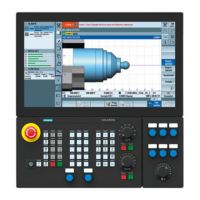Fundamental Principles of NC Programming
2.2 Language elements of the programming language
Fundamentals
Programming Manual, 11/2006, 6FC5398-1BP10-2BA0
63
The data type permitted for the variable is determined when the variable is defined. The data
type for system variables and predefined variables is fixed.
Elementary variable types/data types are:
Type Meaning Range of values
INT Integers with sign -2147483646 ... +2147483647
REAL Real numbers (fractions with decimal
point, LONG REAL to IEEE)
±(2,2*10
-308
… 1,8*10
+308
)
BOOL Boolean values: TRUE (1) and
FALSE (0)
1, 0
CHAR ASCII character specified by the
code
0 … 255
STRING Character string, number of
characters in [...], maximum of 200
characters
Sequence of values with 0 ... 255
AXIS Axis names (axis addresses) only Any axis identifiers in the channel
FRAME Geometrical parameters for
translation, rotation, scaling, and
mirroring
Identical elementary types can be combined in arrays. Up to two-dimensional arrays are
possible.
Constants
Integer constants
Integer with or without sign, e.g., for assigning a value to an address
Examples:
X10.25
;Assignment of the value +10.25 to address X
X -10.25
;Assignment of the value –.25 to address X
X0.25
;Assignment of the value +0.25 to address X
X.25
;Assignment of the value +0.25 to address X without leading "0"
X=-.1EX-3
;Assignment of the value –.1*10-3 to address X
Note
If, in an address, which permits decimal point input, more decimal places are specified than
actually provided for the address, then they are rounded to fit the number of places provided.
X0 cannot be replaced with X.
Example:
Do not replace G01 X0 with G01 X!

